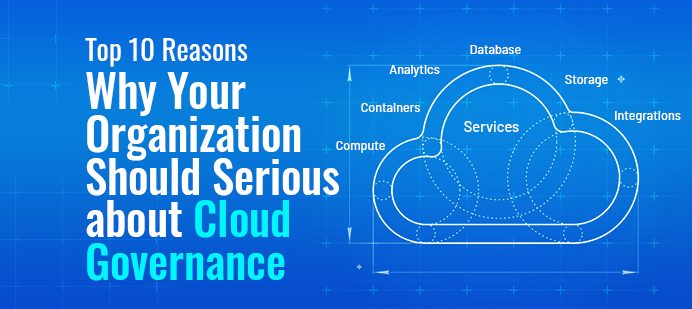Top 10 Reasons – Why Your Organization Should Serious about Cloud Governance
Everyday evolving cloud computing and increased used of cloud infrastructure helping enterprises to explore new horizons, streamlining processes and enabling a tremendous business growth. But with this cloud governance is also becoming important aspect of every businesses that not only provides visibility of every cloud service but also secure your businesses with proper governance and security structure.
You will agree to that, moving from on premises to cloud isn’t a piece of and this requires a complete governance model in place. You might be thinking about what governance model is and why your business requires it implemented within the organization. Well, just like on-premise IT infrastructure, companies relying on the cloud must have control over which apps or software can be accessed within the organization and by which department. In the cloud, the same can be implemented in a couple of seconds. To handle the overall efficiency and costs, businesses must have a certain set of rules. In today’s blog post lets learn what cloud governance is and reasons to rely on cloud governance solutions for streamlined processes.
Here are Top Reason why you should serious about cloud governance
Enhance Efficiency and Optimizing Resources
A cloud governance framework is a set of rules and regulations that regulate how cloud resources are used. Cloud computing governance facilitates the most efficient use of cloud services. The cloud services can be outsourced by the company. External servers, on the other hand, should be governed to minimize any humiliation from data theft.
Improved compliances:
It is necessary for compliance to applicable rules, regulations, and policies. The Cloud Governance model should be implemented in the system so that any violations from the rules and regulations can be detected early.
Interoperability:
The enterprise’s outsourcing or construction of an application with a cloud computing vendor will make switching to a different computing vendor with Proprietary Application Programming Interfaces more challenging (APIs). It will be difficult to achieve application interoperability between two cloud computing companies as a result of this.
As a result, the Cloud Governance architecture allows for data reorganization and application logic changes. It has standards for the successful application of interoperability.
Threshold Policy:
Cloud governance is the policy that governs the testing, development, improvement, and implementation of a program in an organization. It’s a policy that ensures the scalability of a sudden spike in demand by creating more instances to meet the demand.
Improved responsiveness to business needs:
Cloud governance promotes agility by implementing latest technology. It is readily available whenever it is needed. This helps in meeting the needs of stakeholders and the business. It increases transparency and understanding of the business’s contribution. Cloud Governance is explained by all of these factors.
Optimization of Operational Alignment :
Initiatives must be aligned with the business strategy. It decreases reliance on technology. It enhances organizational talents and skills. It also assists in meeting demand scalability. It improves the security and availability of data and services.
Performance Management:
The main bits of Business aims are the discovery of new avenues and the increase in earnings. The addition of streams, production, and the manufacture of new items will all help the company achieve its objectives. Customers are more likely to stay with you if you provide them with excellent services.
Improved Customers Relationship Management:
The cloud governance approach makes it easier to respond to client complaints. It also promotes client satisfaction. It aids in the improvement of service quality and availability. It improves collaboration with customers’ needs and reduces lead times. It helps in the delivery and testing of automated software.
Effective Cost Management:
Cloud governance improves utilization efficiency. It takes expense during the infrastructure’s initialization, but afterward it changes to operating expenses for routine maintenance to avoid any disturbance. As a result, data security has improved.
Improved Security and Incident management :
It helps with access restrictions, which prevent unwanted access and data change. The governance of audit trails is provided by cloud governance in order to locate the initialization of transactions. It also covers topics such as encryption, application access controls, and suspicious activity.
The dedicated team of cloud experts at Network Techlab have worked tirelessly in a multiple project to eliminate blind spots across its client cloud environments. Public cloud assessment service enables organization to check roadblocks in their cloud governance and enhance their posture in to multi cloud environment.





